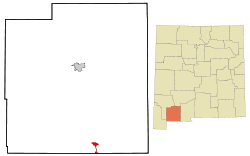Columbus (New Mexico)
| Columbus | |
|---|---|
 |
|
| Location in New Mexico | |
| Basic data | |
| Foundation : | 1891 |
| State : | United States |
| State : | New Mexico |
| County : | Luna County |
| Coordinates : | 31 ° 50 ′ N , 107 ° 39 ′ W |
| Time zone : | Mountain ( UTC − 7 / −6 ) |
| Residents : | 1,765 (as of: 2000) |
| Population density : | 245.1 inhabitants per km 2 |
| Area : | 7.2 km 2 (approx. 3 mi 2 ) of which 7.2 km 2 (approx. 3 mi 2 ) are land |
| Height : | 1240 m |
| Postal code : | 88029 |
| Area code : | +1 505 |
| FIPS : | 35-17050 |
| GNIS ID : | 0897342 |
Columbus is a municipality in Luna County in the US state of New Mexico . It is located across from Palomas in the Mexican state of Chihuahua , about eight kilometers from the Mexican-American border. 1765 inhabitants live on a community area of 7.2 km² (status: 2000).
history
Columbus was founded in 1891 and was even closer to the border then than it is today. In 1902 Columbus received a train station, which also involved relocating the city to its current location, about three miles further north. The city, whose population hardly increased in the following years, is described by contemporaries as not very attractive.
During the Mexican Revolution in 1916, a detachment of the 13th Calvary Regiment of around 350 men was relocated to Columbus to protect the residents and the American border . These were housed in Camp Furlong , which was located on the southern outskirts of Columbus, with which the soldiers stood between the city and Mexico.
On March 9, 1916, around 3:30 am, the Mexican revolutionary leader Pancho Villa (1878–1923) and up to 500 men moved into position not far from Columbus. About half an hour later, at least 380 Villistas , divided into several departments led by his subordinates (Colonel) Francisco Beltrán, (Colonel) Candelario Cervantes, (General) Nicolás Fernández, (General) Pablo López and a few others, attacked the City. Villa did not participate in the attack, but stayed with the reserve with the rest of the men. The attack ended in a complete fiasco, which not only cost the Villistas 105 dead, wounded and missing (or prisoners), but also brought them no significant spoil from the bank, food, weapons and horses. The heavy losses of Villas were offset by losses on the US side of “only” 10 civilians killed and seven or eight soldiers from the garrison. Part of the city had been set on fire by the Villistas . The attack was the last military attack on US territory with ground troops.
On the orders of the then US President Woodrow Wilson (1856-1924), the Americans then undertook a “ punitive expedition ” to Mexico under the orders of General John J. Pershing (1860-1948) , with the aim of bringing Villa and his men to justice to pull. During the duration of this enterprise, Columbus played an important role as a supply base for the soldiers deployed in Mexico.
The end of the so-called Mexican Expedition (English: Mexican expedition ) brought Columbus big changes. Although remained Camp Furlong continues to operate, but with a greatly reduced number of troops. Finally, in 1926, the US Army decided to close the camp because troops were no longer necessary on the Mexican border. That and the shutdown of rail traffic to Columbus resulted in a significant contraction of the urban economy, from which Columbus only began to recover in the mid-1990s. Today Columbus is mainly visited by tourists who stop here on their way to Mexico.
Web links
References and comments
- ↑ The US total losses are stated very differently in the literature. In older works there is often talk of over 20 deaths, the website Pancho Villa raids Columbus names 18 deaths, while Friedrich Katz: The life and times of Pancho Villa . Stanford, Calif .: Stanford Univ. Press, 1998, ISBN 0-8047-3046-6 , p. 566, speaks of 17 Americans killed.
- ↑ A very detailed account of the attack is provided by James W. Hurst: Pancho Villa and Black Jack Pershing. The Punitive Expedition in Mexico. Praeger Publishers, Westport 2008, ISBN 978-0-313-35004-7 , pp. 21-30.
- ^ Go in Peace , Los Angeles Times, May 1, 2016, p. L1.
